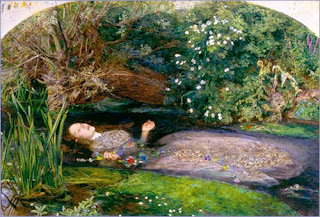Saturday 17th November
In the programme, Roger Spottiswoode is described as having ‘been interested in William Golding’s novel The Spire for many years’. It’s an interest I’ve shared since studying it as a set-text for A’level in 1979. Then, as a seventeen year old, the most vivid parts were the love affair between Goody and Roger Mason, obvious to Dean Jocelin as he sees a net holding them together, and the brutal murder of her disabled husband, Pangall, hunted down and sacrificed by the superstitious builders.
I re-read it in 2006, when I was
working as writer-in-residence at Truro Cathedral – which incidentally has
three spires. Then I was struck less by
the plot, than the extraordinary writing, especially the descriptions of light and sound and
how they relate to the inner workings of Jocelin’s mind, whether in his dreams and visions or as he perceives 'reality'.
‘He blinked for a moment.
There had been sun before, but not like this. The seeming most solid thing in the nave, was
not the barricade of wood and canvas that cut the cathedral in two, at the
choir steps, was not the two arcades of the nave, nor the chantries and painted
tomb slabs between them. The most solid thing was the light. It smashed through the rows of windows in the
south aisle so that they exploded with colour, it slanted before him from right
to left in an exact formation .... the
grains of dust … drifted cloudily, coiled or hung in a moment of pause,
becoming in the most distant rods and trunks, nothing but colour, honey-colour
slashed across the body of the cathedral … the honey thickened into a pillar that
lifted straight as Abel’s from the men working with crows at the pavement .’
(pp.9-10)
So much of the book works symbolically, sometimes farcically with the phallic spire standing for Jocelin’s repressed sexuality that it would seem a difficult book to dramatise. Much of the action is internal, such as Jocelin perceiving the pain of his diseased back as the prescence
of an angel and his own self-deception about his feelings towards Goody, Mason and God.
Another difficulty dramatically is that we know from the outset that the spire
was built and still stands, so the scenes where Roger, the Master Builder and
Father Anselm express objections, have little dramatic tension.
But Gareth Machin’s
production in Salisbury was a brilliant theatrical experience. The set was on a grand scale with a replica
of the tower, its crows nest and the gigantic capstone all suitably precarious,
some great lighting and the monkish chanting automatically atmospheric. The scene where the wedges were hammered out
to allow the risky dropping of the capstone’s weight (which in spite of an
explanation with a censer I didn’t quite understand in engineering terms) was genuinely
thrilling.
There were lots of short scenes, perhaps reflecting Roger
Spottiswode’s earlier screenplay, which didn’t always give the actors much scope. The two women were strongest, perhaps because
the three characters they played genuinely influence the action. Vincenzo Pellegrino as Roger Mason had a
powerful manly prescence, and Mark Meadows as Dean Jocelin moved from a rather
New Labour reasonableness to genuine feeling.The two intervals worked well with each of the first two acts ending with a death – the murder of Pangall, and Goody’s tragic miscarriage, both happening off-stage (and it wasn’t clear to my companion, who hadn’t read the book, that Pangall had died). There was something overly-restrained about the beginning of the play, perhaps intended to highlight the crazier action later as men worked towards achieving the impossible.
One of the strongest scenes dramatically came near the end where Dean Jocelin and Father Adam confront the changes in their relationship as a result of Jocelin’s obsession in an exchange that was sad, touching and timeless.
Some of the reviewers talk about the play’s theme as being
religious faith – I think that’s beside the point here. In medieval times, God was just background,
like air is now, and people’s experience of the machinations of the Church
would be more akin to how we perceive local government rather than a question
of faith and belief.
The main themes to me seems to be vision and persistence and
how one man explains himself to himself, and particularly the role of pride,
both in Jocelin who thinks he’s chosen for this work and Roger Mason who has
the skills to make bricks and mortar happen.
Well worth the trek from Canterbury to Salisbury.








